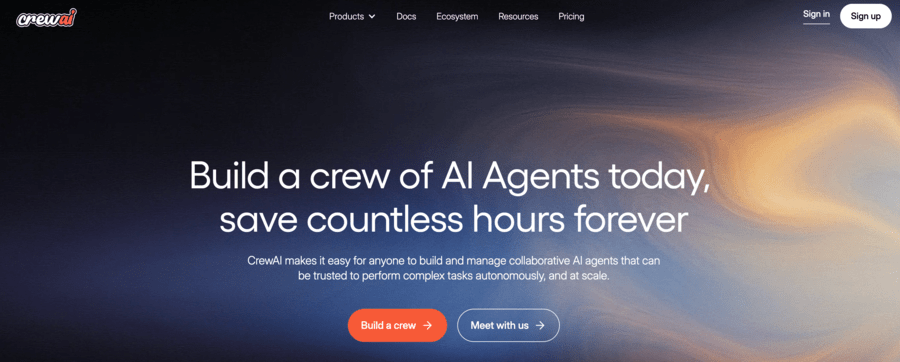
Crew AI

Crew AI is an open-source framework for building and coordinating collaborative AI agents. It enables developers to create specialized agents with defined roles and tools that work together to complete complex workflows. By supporting multi-agent teamwork, Crew AI makes it easier to design scalable, autonomous systems for research, content creation, business automation, and data analysis.
Crew AI Details
Ready to try Crew AI?
Check out Crew AI for pricing and explore how it can streamline your workflow.
Overview of Crew AI
What Is Crew AI
Crew AI is an open-source Python framework for building and coordinating collaborative AI agents. Instead of relying on one agent to complete every task, Crew AI allows developers to create “crews” of specialized agents, each with its own role, goal, and toolset. These agents work together, delegate tasks, and communicate to complete complex multi-step workflows efficiently and autonomously.
Crew AI gives developers both simplicity and control when designing agent collaboration, making it a flexible foundation for multi-agent systems across industries and use cases.
How To Use Crew AI
- Install the framework
Add Crew AI to your Python environment using pip. - Define agents and roles
Create agents with specific roles and goals, such as “researcher,” “writer,” or “analyst.” - Attach tools
Equip agents with tools such as APIs, web search, or data access capabilities to perform tasks effectively. - Build a crew and process
Combine multiple agents into a coordinated crew and define the workflow that manages their collaboration. - Execute and monitor
Run the crew to complete the assigned objective and track how agents interact and perform.
Crew AI Key Features
- Role-Based Collaboration: Assign unique goals and behaviors to different agents.
- Tool Integration: Allow agents to use APIs, databases, and external systems.
- Flexible Workflows: Support sequential, hierarchical, and parallel coordination between agents.
- Delegation and Communication: Enable agents to share context and delegate subtasks intelligently.
- Model Flexibility: Compatible with a variety of large language models and backends.
- Open Source and Scalable: Free to use, extend, and deploy for enterprise-grade applications.
Crew AI Use Cases
- Content Pipelines: Assign research, writing, and editing tasks to separate agents working together.
- Business Automation: Manage marketing, data entry, and customer support through cooperative AI teams.
- Data Research and Analysis: Combine agents that collect, clean, and interpret data collaboratively.
- Workflow Orchestration: Manage multi-step processes that require specialized knowledge at each stage.
- Hybrid Collaboration: Combine human input with AI agent decision-making in team workflows.
Crew AI FAQ
Is Crew AI free or paid?
Crew AI is open source and free to use.
Do I need to control each agent manually?
No. Agents in a crew coordinate, communicate, and delegate tasks automatically once configured.
Does Crew AI store data?
Crew AI does not store data by itself. Data handling depends on the developer’s setup and persistence options.
What types of projects is Crew AI best for?
Crew AI excels at complex, multi-step tasks that benefit from specialization and coordination between multiple agents.
Can Crew AI connect with external systems?
Yes. Crew AI allows agents to integrate with APIs, web services, and databases through custom tools.
Why We Featured Crew AI on Add AI Agents
At Add AI Agents, we highlight frameworks that make intelligent collaboration between agents possible. Crew AI stands out for its modular design and team-based approach, allowing developers to build systems where multiple AI agents work together seamlessly. It represents a new era of agentic architecture that mirrors human teamwork, providing reliability, structure, and adaptability in automated workflows.
Ready to try Crew AI?
Check out Crew AI for pricing and explore how it can streamline your workflow.
Explore More AI Agents
Discover other AI agents and tools to enhance your workflow and productivity.
Browse All AgentsSimilar to Crew AI
View All Agents →
Antigravity
Antigravity is an agent driven development platform from Google that allows AI agents to write, test and validate software inside a complete desktop environment. It gives agents controlled access to the editor, terminal and browser so they can generate code, run applications and provide clear evidence of their work through artifacts like plans, diffs and recordings. By combining multi model intelligence with autonomous task execution, Antigravity acts like a dependable engineering partner that handles routine development, verifies results and supports higher level workflows. Its dual workspace system and multi agent coordination features help teams move faster, maintain cleaner code and build software with greater confidence and efficiency.

Devlo
Devlo is an AI powered engineering partner that helps software teams build, review, and maintain code with greater speed and consistency. It connects directly to your repositories and development workflow to automate issue resolution, generate pull requests, analyze code quality, and support day to day engineering tasks. By combining code understanding, workflow automation, and intelligent collaboration features, Devlo acts like an always available teammate who can handle routine work, enforce best practices, and improve overall productivity. With integrated project management, code analysis, and automated contributions, Devlo helps teams scale development output while keeping codebases clean, secure, and well organized.

Codemender
CodeMender is an AI powered security agent that automatically detects, analyzes, and repairs software vulnerabilities at scale. It combines advanced program analysis, multi agent reasoning, and automated validation to help developers secure their codebases with greater speed and accuracy. By integrating debugging tools, static and dynamic analysis, fuzzing, and intelligent patch generation, CodeMender can identify root causes, create high quality fixes, and rewrite unsafe code patterns before they become exploitable. With autonomous reasoning, safety checks, and human review workflows, CodeMender gives teams a reliable way to maintain secure code, eliminate entire classes of vulnerabilities, and strengthen the long term resilience of their software.
Trending AI Agents
View All Agents →
Google Ads Advisor
Google Ads Advisor and Analytics Advisor are AI powered assistants that help advertisers optimize campaigns, understand data, and make faster decisions across Google Ads and Google Analytics. They combine generative AI, real time insights, and account level learning to simplify how marketers manage performance. By integrating optimization tools, conversational analysis, and automated recommendations, the advisors make it easier to create high quality assets, discover growth opportunities, troubleshoot issues, and improve results. With personalized guidance, natural language interaction, and automated actions, these AI agents help teams streamline workflows, reduce manual effort, and scale more effective advertising strategies.

Agno
Agno is an AI-native workspace that allows teams and developers to build, deploy, and manage intelligent agents from a single platform. It combines model integration, workflow automation, and collaboration tools to streamline how AI systems are created and operated. With visual builders, API support, and enterprise-level management, Agno makes it easy to orchestrate multi-agent workflows, connect large language models, and scale production-ready AI solutions.

Pomelli
Pomelli by Google is an AI-powered reasoning and research workspace that combines structured intelligence, collaboration, and Google’s ecosystem into one adaptive environment. It enables users to explore ideas, analyze information, and build reasoning chains with full transparency. Integrated with Gemini and Google Search, Pomelli helps individuals and teams connect data, context, and insights across documents, Drive, and the web. Designed for researchers, strategists, and professionals, Pomelli transforms unstructured thinking into organized, explainable knowledge.
